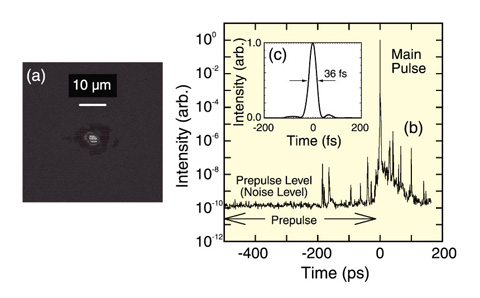
Fig.5-3 Focal spot and temporal profile

Fig.5-4 Results for this experiment and other studies
It is well known that when a laser beam is focused on a metal foil or a plastic foil target, hot electrons are produced and ejected from the back of the foil target. When these hot electrons leave the thin foil target, a strong electric field is generated owing to charge separation. Protons from contaminants, such as water or oil on the back side of the foil target, are accelerated by this electric field. To apply this laser-driven proton source to ion cancer therapy, etc., it is necessary to produce high-energy protons by tightly focusing the laser beam. A 70 MeV proton beam was reportedly produced by a single-shot base large glass laser system. In addition, a 25 MeV proton beam was produced using a repetitive Ti:sapphire laser system.
In this study, we used the J-KAREN laser system (JAEA Kansai Advanced Relativistic Engineering Laser). To efficiently focus the laser beam on a target, deformation of the wavefront of the laser beam transmitted from the laser system to the target was suppressed as much as possible. We focused a laser beam with an energy of 7.5 J onto a target in a 2 μm spot (Fig.5-3(a)). The laser intensity on the target reached 1021 W/cm2. As far as we know, there have been no reports of the observation of any physical phenomena corresponding to a 1021 W/cm2 interaction, although the generation of over 1022 W/cm2 has been achieved. Using an optical phase control technology for the laser system and a pulse-shape measurement technique, we produced a low prepulse level of 10-10 (Fig.5-3(b)) and a pulse width of 36 fs (Fig.5-3(c)). If the prepulse level is very high, it affects the foil target before the main pulse arrives. In this experiment, because the contrast was approximately 10-10, the foil target was not damaged before the main pulse arrived. As a result, we could irradiate the foil in spite of high intensity. Thus, we generated a 40 MeV laser-driven proton beam (Fig.5-4(d)(e)). The energy of the generated proton beam was estimated from the range of the protons using a CR39 nuclear track detector.
Because of the deep stopping range for small animals, this new proton source can now be used in preclinical experimental studies of in vivo proton therapy. We believe that this laser-driven proton generation technique reduces the size of the particle accelerator system required for cancer therapy. It is also expected that this laser-driven proton source can be applied not only to other medical applications but also to other proton acceleration applications.